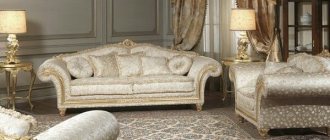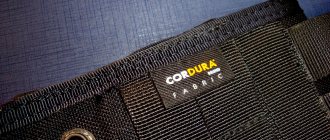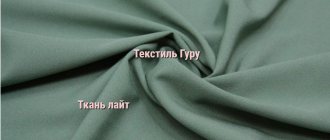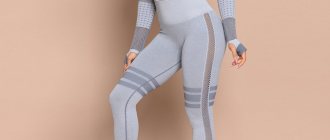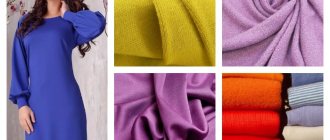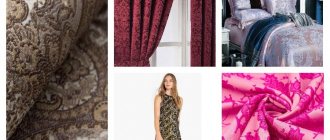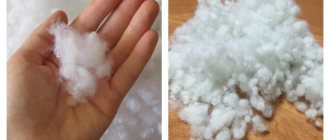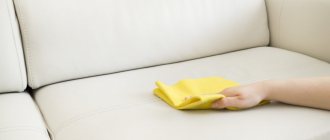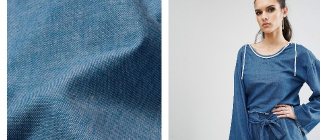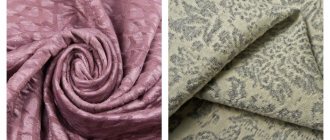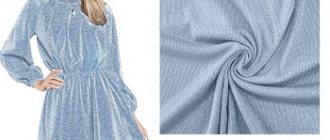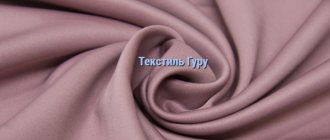There can be no clear answer to the question of which fabric is better. It all depends on the scope of its application, required functional properties, composition, price, in the end. The manufacturer is always guided when choosing by the cost of the material, the strength characteristics, and the durability of the future product.
Therefore, it would be correct to ask which fabric behaves under the right conditions and how long it will “live”. And depending on this, consider the materials and decide which is better and which is worse.
You can divide all fabrics into several large-scale categories:
- naturalness;
- application in tailoring;
- household use.
Here we will talk about them in more detail.
Description
So, stretch fabric, what is this elastic material that stretches perfectly, fits the figure and drapes. The stretch attachment unites a group of fabrics. Elastic properties are provided by the addition of spandex, lyra or elastane to the base composition of natural, artificial or synthetic threads. The percentage of elastic component ranges from 1-30%.
Spandex fiber has a unique structure. In it, flexible fragments of polyurethane are connected into a single chain by rigid bonds, which determine the degree of elasticity and prevent the particles from diverging. Lycra is not found in its pure form, but only as an additional component to impart elasticity and increase service life.
Elastane fibers are produced matte and shiny, transparent and translucent, so that, if necessary, they can add gloss to the material or remain completely invisible.
In English, the word "stretch" means to stretch.
The degree of stretch depends not only on the amount of spandex, but also on which thread it was added to: a piece, a weft, or both at once. Accordingly, you will get a mono-stretch that stretches in only one direction or a bi-stretch that stretches in any direction. Outwardly they are no different. The type is easily determined by the application of force.
Stretch knitwear and its composition
Italian fashion designers were the first to promote tight-fitting, sophisticated, but comfortable clothing. Comfortable knitwear has conquered the whole world. It’s hard to imagine, but previously even hosiery consisted of 100% natural ingredients. They wore out quickly, which is why the clothes were so expensive. Stretch knitted products are used both in wardrobe and in medicine.
Compression garments are made from stretchable knitted fabrics. It fixes the joints well and regulates blood flow after surgery.
Flexible knitwear consists of admixtures of various components. Depending on what properties the product should have, synthetic threads are woven into natural or artificial ones. The most common:
- polyamide is a material that can withstand heavy loads during stretching, it easily returns to its original position;
- Lycra is a strong and soft thread that can be modeled well;
- microfiber – suitable for insulating things;
- Tactel - new generation polyamide threads that allow air to pass through.
Different types of weaving and percentages of ingredients affect the density, softness and strength of stretch knitwear.
Types of mono-stretch fabrics
Even a small addition of lycra can change the properties of any material that immediately receives the “stretch” prefix. The main types of textiles with one-way stretching:
- Stretch jeans are a dense, medium-hard material that is resistant to mechanical stress. Used for comfortable everyday wear: trousers, dresses, shirts and jackets. Denim pants made from this material fit perfectly on the figure.
- Jersey is an elegant fabric made popular by Coco Chanel. Used for sewing dresses, suits and underwear. The composition can be synthetic and mixed. The fabric is highly elastic in the transverse direction, but has little stretch in length. Looks beautiful with folds and draperies. The material has also found use in the production of bathrobes, sleepwear and children's clothing.
- Thanks to elastane, stretch linen becomes more comfortable and almost does not wrinkle.
- Poplin is a ribbed cotton fabric for bed linen and summer clothing. Soft and dense material with high hygienic properties.
- Stretch velvet is a rich fabric with a good fit. Designed for evening and theater wear.
- Barbie is a suiting fabric for business wear and school uniforms. It is soft, durable and form-fitting due to its light stretch. Provides air exchange, does not wrinkle and lasts a long time.
- Stretch silk, which successfully combines strength and elasticity with gloss and chic. Suitable for party dresses, bedding and underwear.
- Tiar is a costume fabric, strict and versatile. It has a smooth surface with a small, diagonal ridge. 2% elastane content for a perfect fit. Suitable for dresses, jackets and suits.
- Stretch wool softly fits the figure, warms and does not wrinkle during prolonged sitting.
- Gabardine is a durable material made from wool or cotton with the addition of synthetics. It is distinguished by diagonal weaving of warp and weft threads. Keeps its shape well, light and thin.
- Bengaline is an airy and beautiful material, similar to silk. Produced mixed, natural or synthetic. Lycra content 2-5%. It does not wrinkle, retains its shape and is soft to the touch. The peculiarity is that the material stretches well in the longitudinal rather than transverse direction.
l
Lavable: washable, lightweight, crepe-like, flowing fabric with a smooth surface, made from silk or chemical fibers.
Lame: A shiny, iridescent fabric with metallic and other threads with a sheen.
Loden: medium to heavy wool fabrics, very dense due to felting and very durable. Shaggy loden is a fabric covered with a long pile adjacent to one side; cloth loden is a fabric with a matte, lint-free surface, reminiscent of felt.
5 - knitwear with a piled/terry backing; 6 - knitted fabric
Types of bi-stretch
Bi-stretch fabrics are comfortable and attractive. The most popular materials include:
- Biflex, which is translated as “stretching in two directions.” The dimensions of the canvas can increase three times. It is durable and has a durable color in rich colors. Some types have decorative effects, flickering and holographic. Thermal conductivity and ability to absorb moisture allows you to use the fabric for hot days and carry out workouts comfortably. It is used for swimsuits, sportswear, stage and dance costumes, as well as for handicrafts; dolls are made from it.
- Diving or "second skin" consists of synthetic fibers such as polyester and lycra, as well as rayon and sometimes cotton. It has high strength and a shiny surface. It comes in two variants; microdiving for T-shirts and summer dresses and diving stretch, which is successfully used for sports jersey and shapewear. Clothing made from this fabric gives a slim silhouette and hides a few extra pounds.
- Kulirka and ribana are highly elastic knitted fabric made from natural cotton fibers with the addition of 5% lycra. The fabrics have high hygroscopic and breathable properties, are hypoallergenic and safe. In addition, they are durable and tear resistant. Mainly used in sewing children's clothing and items for newborns.
- Footer fabric is brushed cotton jersey, cozy and unpretentious. A small percentage of lycra enhances strength and elasticity. Suitable for children's items, home and sportswear.
- Butter is a soft, flowing and durable material made from viscose, polyester and lycra. It gracefully fits the figure and is pleasant on the skin. It can be plain and printed, matte or with a slight shine.
Advantages in clothing
An attractive feature of stretch fabrics is their ability to retain their shape and restore their original size. On a person, clothing follows the lines of the body, and after removal it corresponds to the contours when cutting. This quality allows you to create tight-fitting products and slimming, shapewear.
What is stretch fabric in clothing:
- Elasticity and extensibility;
- Shape stability and wrinkle resistance;
- Strength and wear resistance;
- Lack of burnout and destruction under the influence of external factors;
- Thanks to lycra, clothes become less dirty and stains are easily washed off;
- Air and thermal conductivity;
- Hygroscopicity.
The synthetic component gives the textile the characteristics of natural fibers. It is worth noting that when adding spandex to cotton or wool no more than a third of the composition, their performance qualities are preserved and enhanced by the properties of synthetics.
The disadvantage of viscous fabrics is their tendency to shrink significantly, so you should be careful when washing and caring for them.
Spandex is in demand in the medical field for the manufacture of bandages, elastic bandages, compression garments and knitwear.
Technological and operational properties of tensile fabrics
They depend on the raw material composition. They are in great demand among consumers. Sewing any product is not particularly difficult, because the pattern can be created in a few minutes. The dressmaker does not have to deal with adjustments; the ideal fit is ensured due to the stretchability of the fabric.
Elastic materials are very soft and easy to drape. Stretch fabrics do not require special care and are easy to wash and dry. The products do not need to be ironed as they do not wrinkle.
Let us list the properties of stretch materials:
- strength;
- elasticity;
- hygroscopicity;
- drapeability;
- wear resistance;
- evenness of threads;
- breathability;
- low crumbling;
- no shrinkage;
- ease of care.
In addition to the fact that sewn products do not lose their shape, they provide comfort and maximum ease of wearing. Even if synthetic fibers predominate in the composition, the fabrics are suitable for sewing clothes for any season, since they contribute to normal thermoregulation.
Application
Stretch fabrics are especially valued in clothing. In addition, the elastic material looks great in furniture upholstery and home textiles.
- All types of women's clothing: dresses, skirts, blouses, jackets;
- Tight and tight trousers, jeans and leggings;
- Dresses for special occasions;
- Sportswear, suits and tights;
- Men's shirts and jackets;
- Dressing for theater and circus performers;
- Underwear items;
- Swimwear for children and adults;
- Socks and knee socks;
- Women's stockings and tights.
Fabrics for sewing bedspreads, covers, decorative pillowcases and capes are made from fabrics with the addition of spandex. The pliability of the material makes it easy to obtain the desired shape.
Care
What you should know about caring for stretch products:
- Avoid intense mechanical impact during washing. Avoid spinning at high speeds, twisting and rubbing contaminated areas.
- Sudden temperature changes during washing and rinsing lead to shrinkage.
- Wash by hand or on delicate cycle.
- Limit water heating to 30°.
- Do not use aggressive chemicals and bleaches;
- Leave wet items to drain naturally.
- Dry flat or on hangers away from sunlight and heat sources;
- Stretch items do not require ironing. If necessary, the heating regulator is set to the “synthetic” or “silk” position, and the iron is moved over the surface without stretching movements.
Important!
It is prohibited to steam elastic products. This leads to shrinkage.
